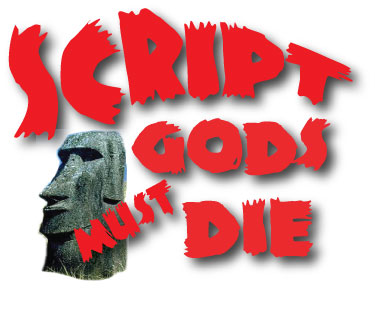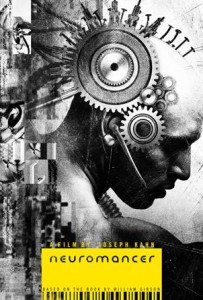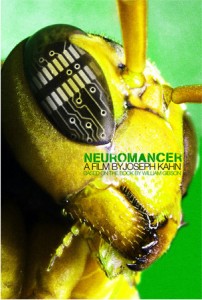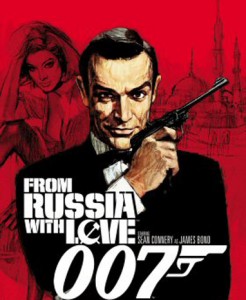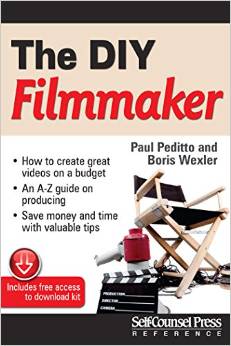Once you’re writing with POV, don’t forget to avoid the booby-traps. For instance, directing the script. From Nueromancer:
CAMERA BOOMS DOWN onto the spread eagled Case, surrounded by his enemies. He screams as the mycotoxin hits his nervous system like a runaway freight train. His dilated eyes flash open, staring into a hallucinatory hell.
BOOM DOWN continues straight through the glistening black hole of his pupil and on into a chilling inner void.
SMASH CUT TO:
EXT. CHIBA CITY, JAPAN – NIGHT
A crowded commercial ghetto in the Ginzu district of Japan; a garish strip of bars, liquor stores, and cosmetic surgery parlors. The ragtag crowd of hustlers and tourists wear rough trade street fashions with the added kink of punk influenced elective surgery...notched ears and lidless eyeballs...added strictly for shock value. The holographic adverts hanging like neon ghosts in the night sky remind us this is the future. A grim future indeed.
Hey, some great writing here. Look at that description of Chiba City above. Problem is the BOOM DOWN stuff, the SMASH CUT TO, etc. For a spec screenplay, you want to avoid these. Please don’t write it like From Russia With Love:
FADE IN:
EXT. RENAISSANCE GARDENS – NIGHT – SERIES OF SHOTS
– WIDE MOVING SHOT: Bond, dressed in a tuxedo, walks across a bridge and down some steps as if stalking someone. He looks back.
– CLOSE SHOT: The feet of another man, wearing sweat-pants and soft shoes, walk forward.
– CLOSE SHOT: Bond turns forward again, looks around and continues walking.
– CLOSE SHOT: The other man’s feet walk quietly up some steps.
– WIDE MOVING SHOT: Bond runs down a tree-lined path toward a statue, hears a bird coo and looks back.
– WIDE SHOT: The other man is crossing the bridge. He is DONALD GRANT. He stops and looks in front of him.
– MEDIUM SHOT: Bond, holding a revolver, moves toward some trees.
– MEDIUM SHOT: Grant stops on the bridge, looking forward, then cracks a branch of a tree.
– BOND stops suddenly at the sound. He looks back, pauses thinking, then continues walking.
– GRANT watches, then moves forward and
– GRANT’S FEET walk forward but stop, pivot back and walk in a different direction.
– MEDIUM MOVING SHOT: Bond looks back, walks forward, hears a bird cooing again, looks back, then walks forward again.
– WIDE ANGLE: Bond stops moving and peers behind some bushes. Grant crosses in f.g. holding one arm out.
– BOND fires a revolver.
Do this, and it won’t matter how you tell your story. They won’t read past page 1, let alone the full script.
Another booby-trap is forgetting to tell the story in the cut. Look at this student example:
Edna kisses her husband, making sure he’s ok. When she realizes he doesn’t need any help she goes downstairs to put all the clothes in the laundry. A few minutes later the door bell rings. Edna runs upstairs to see who it is.
What needs work here?
- The camera can’t see “she realizes.”
- We follow her downstairs without a cut? Scorsese does this in Goodfellas (outside club, through kitchen, to front of house table waiting and Franky Valli) or Raging Bull (DeNiro emerges from training room, through crowd, into the ring). Epic filmmaking, but here? To do laundry? Gus Van Sant does it in Elephant for the sake of claustrophobia, for POV. If I need her in the laundry room for story purposes, fine, if not, cut it. Tell the story in the cut.
- “A few minutes later the door bell rings.” Are you saying we haven’t cut yet? What is the camera seeing for “a few minutes”? Sorry, I’m not paying $10+ to watch her dirty laundry spin.
This is two separate scenes, maybe three, depending on need. Do I need to see her putting clothes in the machine? How does that advance character or plot? Please ask these questions before you do the same with your writing.
Let’s try another student example. Examine this paragraph:
Edna cleans up Ricky’s room as they talk and he explains to her how he came here. The shot flashes back to a neighborhood where the audience hears the sounds of loud music, Ricky and his little brother are in front of the store...it’s his little bro’s birthday.
As they come out from the electronics store bullets hit them both. They were in the middle of a drive by the bullet hits Ricky’s neck and he falls. He is dead. The scene cuts to Ricky’s room where he is still with Edna. The wide shot reveals that the room is cleaned and she has been listening to Ricky’s story.
So, what needs work?
- Don’t direct the screenplay. “The shot flashes…“ “The scene cuts to” “The wide shot reveals…” Never give camera directions, never speak of camera location or angle.
- No screen direction more than five lines. Assuming every word is needed (it is not) move to a second paragraph. Give white space. Three paragraphs here, not one.
- “…as they talk and he explains to her…” If it’s dialogue, write it as dialogue, not in screen direction.
- “They were in the middle of a drive by…” Never use past tense. The movie (and script) is unfolding now, present tense.
- Nothing in the head can be seen by the camera. Generally keep screen direction to what we can see or hear.
How would I rewrite this? Maybe something like this:
RICKY
Yeah, we were on 4th.
FLASH --4TH & C
Young Ricky and brother look through a video game store window. Ricky points out a Nintendo game.
A slow moving car stops. A window lowers, two TEC-9 semi-automatic pistols...
GUNSHOTS.
Gangbangers fly out of the store, firing back, running by Ricky, who looks down.
His brother, on the pavement, a pool of blood gushing under his head...
BACK TO PRESENT
Ricky looking to Edna, and the room, now immaculate.
Check your pages, make sure you don’t fall into any of these traps.
